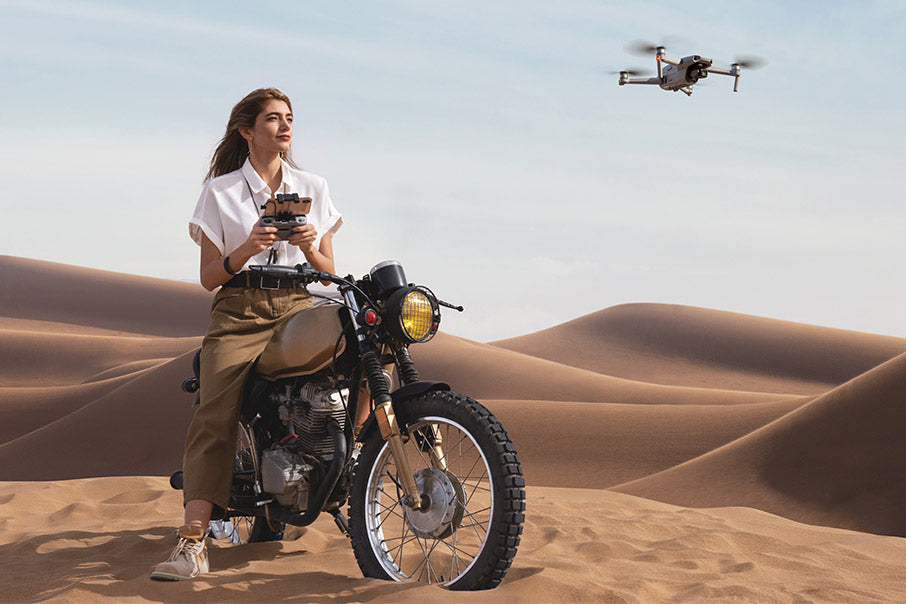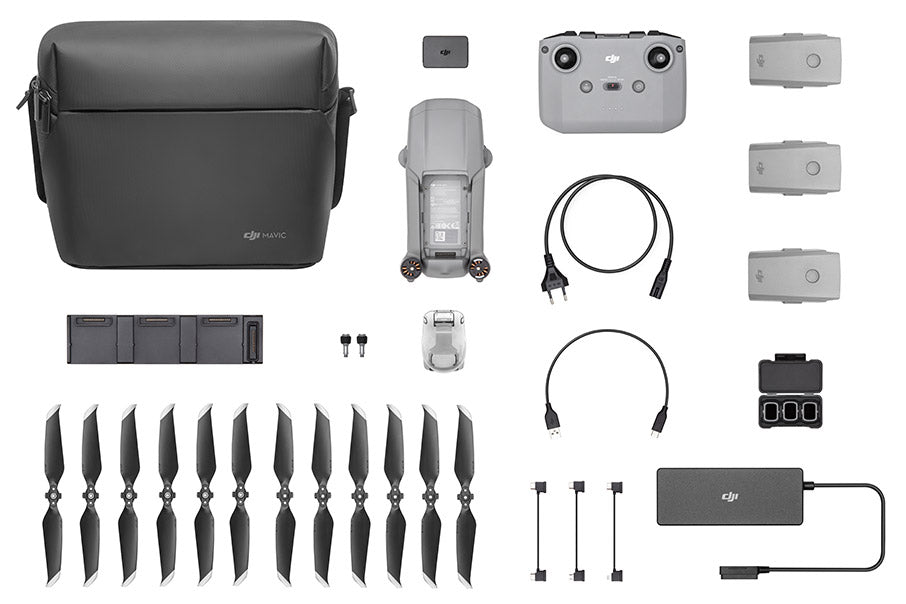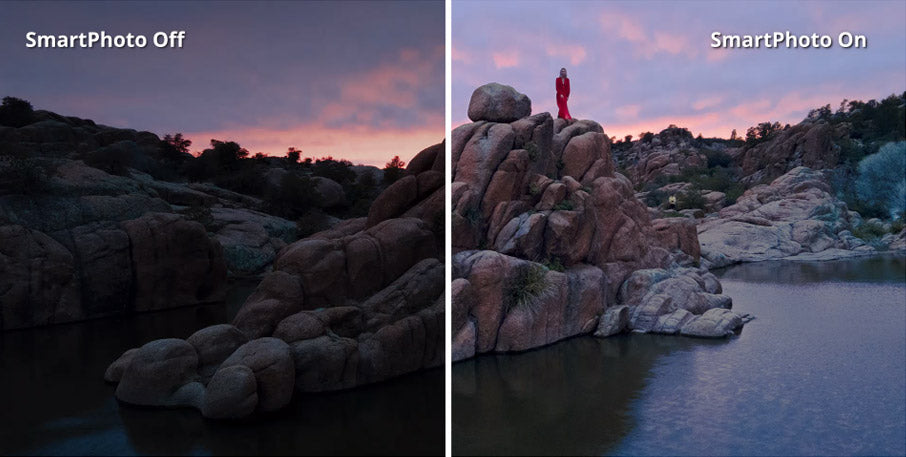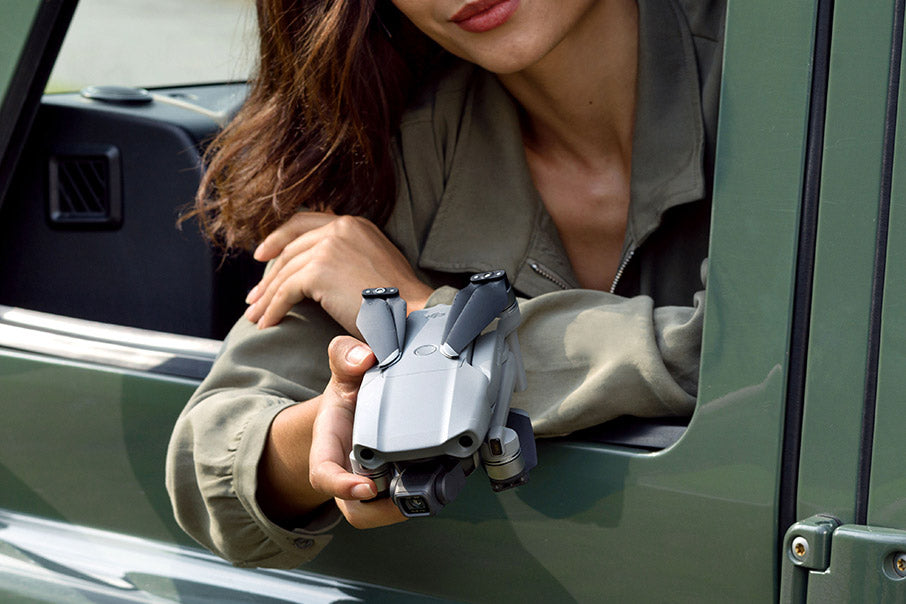It has been over two years since the original Mavic Air release, an inexpensive, folding quadcopter that introduced a new group of consumers to the exciting world of drones. DJI have truly ‘upped their game’ with the release of the Mavic 2 Air, their newest quadcopter sporting the latest advancements in image capture/processing and smart autopilot flight.
Mavic 2 Air at a glance
- Compact folding quadcopter
- ½-inch Sony image sensor
- 4k video@ 60fps and HD video @240fps
- 48MP Photo with enhanced HDR and 8K Hyperlapse
- 34 Minute max flight time
- Occusync 2.0 with 6km maximum range (CE)
- Advanced Focustrack autopilot and obstacle avoidance
- 180×97×84 mm folded and just 570g
Where does this fit in the DJI lineup?
A mid-range drone, it fills the gap between the Mavic Mini and Mavic 2 Pro/Zoom, left by the now defunct Air and Spark. Priced similarly to its predecessor, specification wise it sits closer to the higher end Mavic-2-based craft. We feel it is the ideal drone for vloggers and travelling content creators looking for a portable drone that can capture incredible photos and footage with minimal effort. With the autopilot tracking and obstacle avoidance safety features, the Air is easier and safer to fly than ever. We feel it is likely to be the king of consumer drones this year, the go-to all in one solution for many people.

UK release date : Where can I buy the Mavic 2 Air?
Due to uncertainties in supply chain due to the pandemic, we currently have no lead time for the Mavic 2 Air; However we expect to receive the drone this summer. If you are interested in purchasing the Mavic 2 Air, please see our listing and hit the big blue ‘notify me when available’ button so that we can email you when stock arrives.

When it does, the Mavic 2 Air will be available in two ‘flavours’. The first, a standard pack including the aircraft, propellers, controller, charger, the usual multitude of cables and an ‘intelligent flight’ battery. Then a second, likely more popular ‘Fly More’ combo that also includes a battery charge hub, power bank adapter, ND filters, additional propellers, two extra flight batteries and a shoulder bag to carry it all.
What are the improvements over the old Mavic Air?
The Mavic Air 2 is an all-new drone that shares very little with its predecessor.
A slightly larger Sony camera sensor results in better low light performance with an expanded ISO range plus a higher pixel count. Much has been made of the intelligent photo processing (presumably in-drone) ‘Smart photo’ for high dynamic range output with optimised colours. HDR isn’t just limited to stills, with new support for video. The headline 8k hyperlapse and 240fps @1080p modes are impressive but most consumers will likely see more use from the 60fps @4k filming modes.

Whilst a third heavier, the battery capacity has increased over 40%. Combined with new motors, ESC and folding propellers the drone can now fly for a staggering 34 minutes, 13 minutes longer than the original and still crack 42.5mph.
The addition of Occusync 2.0 has meant a control range of up to 6km over both 2.4 and 5.8Ghz when used in the UK. It retains both GPS+GLONASS receivers and has gained downward-facing obstacle sensors along with APAS ‘3.0’ obstacle avoidance capability. DJI’s autopilot modes version numbers help consumers understand the advancements, the new drone supporting Focustrack, Spotlight 2.0, POI 3.0, Activetrack 3.0. We reserve judgement on their performance until we have had a chance to fly the drone ourselves.

Beyond the aircraft, the transmitter has also been re-designed to a new chunkier form. Gone is the under-slung folding arm design, replaced with a top mounted extending clamp compatible with today’s giant smartphones for securing your device above the controls for a more natural ‘heads up’ operation. You can still unscrew the sticks from the controller should you wish to stow it in your pocket. Note that there is no mention of the gimmicky gesture control, or even direct WiFi smartphone control.
How does it compare to the Mavic 2?
At time of writing we are yet to fly the new drone, thus any conclusions are drawn from the ‘on paper’ specifications. Despite the resemblance to the Mavic 2, the Air is noticeably smaller than its big brother, barely any larger than the first generation model.
The Air appears to narrow the gap between the Mavic 2 in both capability and price. Whilst it doesn’t have side obstacle avoidance sensors, it can stay in the air 3 minutes longer. It can shoot 48MP stills, bigger than the 20MP of the Mavic 2. Interestingly it has a higher effective bit rate, 120Mbps compared to the Mavic 2’s 100Mbps. Airsense is enabled in the drone, providing the pilot with useful warnings of manned aircraft in the vicinity.

Aimed at more casual flyers, the Air does not use the DJI GO 4 app with its fine exposure controls, instead locked to the same DJI Fly app as the Mavic Mini, which, in it’s defence has excellent auto-media generation capabilities.
Should I buy the new drone?
If you are sat at home with the original Air, contemplating a new drone, we believe this is a sensible buy. Now effectively dominating the drone market, DJI have slowed their release cycle potentially to stop competing with themselves. That, alongside the cutting edge feature set found on this drone, suggest that it will be a while until it is eclipsed by a replacement. Bear in mind that the 570g take-off weight will require you to register with the CAA as an operator and display your ID on the quadcopter.
RC Geeks : DJI Enthusiasts
Having stocked every DJI drone since the original Phantom 1 back in 2013, RC Geeks have been at the forefront of consumer drone sales in the UK. We are uniquely positioned to advise you on purchasing DJI equipment, if you have any questions please feel free to message us here.
We have reviews of the latest DJI drones such as the Mavic Mini and Mavic 2. Our teardowns for the original Mavic Air, Mavic Mini, Mavic, Mavic 2, Spark, Inspire 2 and other drones have proved popular as a resource for repairers, so keep your eye on our blog for an upcoming Mavic Air 2 disassembly soon.
Do you have any observations or questions about the new drone? Perhaps you want us to test it in a certain way when it lands in our offices. Please leave your corrections and comments below!

















